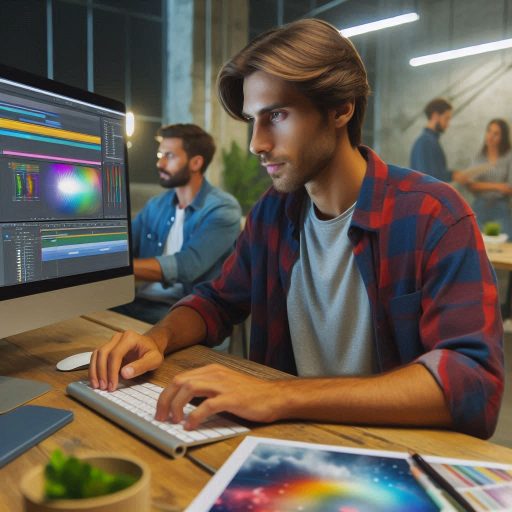Introduction
Motion graphics design involves creating animated visual content that combines graphic design principles with movement.
This technique brings static images to life, enhancing storytelling and engaging viewers.
Motion graphics often appear in videos, advertisements, and online content, capturing attention and delivering messages effectively.
Various industries, including entertainment, marketing, and education, rely heavily on motion graphics design.
Companies use motion graphics to convey complex information simply and engagingly.
In advertising, brands utilize animated content to create memorable campaigns that stand out in a crowded marketplace.
Educational institutions employ motion graphics to enhance learning experiences, making difficult concepts more digestible.
As technology advances, the demand for motion graphics designers continues to rise.
With the increasing popularity of video content across platforms, businesses seek professionals who can create high-quality animations.
According to industry reports, the motion graphics field is expected to grow significantly in the coming years.
Emerging technologies, such as virtual reality and augmented reality, will further expand opportunities for motion graphics designers.
Designers who adapt to these trends will find themselves in high demand.
By honing their skills and staying updated with industry developments, motion graphics designers can secure rewarding careers in this dynamic field.
Current Demand for Motion Graphics Designers
Statistics on the Current Demand for Motion Graphics Designers
The demand for motion graphics designers continues to rise significantly in today’s digital landscape.
According to the U.S. Bureau of Labor Statistics, employment for multimedia artists and animators is projected to grow by 8% from 2021 to 2031.
This growth reflects an increasing need for engaging visual content across various platforms.
Companies recognize the importance of motion graphics in capturing audience attention and conveying messages effectively.
Additionally, a recent survey by Creative Skills East found that 75% of marketing professionals believe video content enhances their campaigns.
With video becoming a preferred format for consumers, businesses actively seek skilled motion graphics designers.
This trend indicates a promising future for individuals entering this field.
Furthermore, industries that previously relied on static visuals are now adopting motion graphics, further driving demand.
Examples of Industries That Heavily Rely on Motion Graphics Design
Several industries heavily rely on motion graphics design to enhance their communication strategies.
The entertainment industry, particularly film and television, uses motion graphics extensively for title sequences, promotional materials, and visual effects.
These elements enhance storytelling and engage viewers, making motion graphics an integral part of production.
The advertising sector also utilizes motion graphics to create compelling commercials and social media campaigns.
Brands increasingly focus on video marketing to capture consumer attention, leading to higher demand for skilled designers.
Moreover, the education sector embraces motion graphics for e-learning platforms, using animations to explain complex concepts visually.
In the tech industry, companies use motion graphics in product demos and tutorials.
These visuals help convey intricate information quickly and engagingly.
Similarly, the gaming industry relies on motion graphics for trailers and in-game animations, creating immersive experiences for players.
How Technology and Digital Media Have Increased the Need for Motion Graphics Designers
Technology and digital media have dramatically increased the need for motion graphics designers.
The rise of social media platforms has transformed how brands communicate with their audiences.
Short video content, often accompanied by engaging motion graphics, dominates platforms like Instagram, TikTok, and YouTube.
As consumer preferences shift toward video consumption, businesses invest more in high-quality visual content.
This trend creates a higher demand for skilled designers who can produce eye-catching motion graphics.
Advanced software and tools have made it easier to create professional-quality animations, attracting more individuals to this career path.
Moreover, the rise of virtual reality (VR) and augmented reality (AR) has opened new avenues for motion graphics design.
Designers can create immersive experiences that blend real and digital worlds, enhancing user engagement.
As these technologies evolve, the need for skilled motion graphics designers will likely increase.
The future job outlook for motion graphics designers appears promising.
Statistics show significant demand across various industries.
As technology continues to advance, motion graphics design will play a crucial role in shaping visual communication.
Aspiring designers should seize this opportunity and develop their skills to thrive in this dynamic field.
Read: Freelance vs. In-House Costume Design Jobs
Growth in Freelance Opportunities
The Rise in Freelance Opportunities for Motion Graphics Designers
The demand for motion graphics designers has surged in recent years.
Businesses increasingly recognize the power of visual content in marketing.
Video content, in particular, has become essential for engaging audiences.
This shift has opened numerous freelance opportunities for motion graphics designers.
Many companies prefer to hire freelancers for specific projects rather than full-time employees.
Freelancing allows motion graphics designers to work with diverse clients across various industries.
This exposure enhances their skill sets and broadens their portfolios.
Additionally, freelancers can choose projects that align with their interests and strengths.
Platforms like Upwork and Fiverr have made it easier for designers to connect with potential clients.
As a result, many motion graphics professionals are transitioning from traditional roles to freelance careers.
The rise of remote work has also contributed to this trend.
Designers can collaborate with clients from around the world without geographical constraints.
This flexibility appeals to many creative professionals seeking a better work-life balance.
Freelancing offers the opportunity to set one’s own schedule, leading to increased job satisfaction.
Advantages and Disadvantages of Freelancing in the Field
Freelancing in motion graphics design has its advantages and disadvantages.
One significant advantage is the ability to set your own rates.
Designers can charge based on their expertise and the complexity of the project.
This can lead to higher earnings compared to traditional employment.
Freelancers also enjoy the freedom to choose their projects.
They can work on tasks that inspire them and align with their skills.
This autonomy often results in higher job satisfaction.
Furthermore, freelancing allows for a flexible work schedule.
Designers can tailor their hours to accommodate personal commitments.
However, freelancing also comes with challenges.
Income can be inconsistent, especially when starting.
Designers may face periods of low demand, making financial stability difficult.
Freelancers must also manage their own taxes and business expenses, which can be time-consuming.
Additionally, finding clients can be challenging, particularly in a competitive market.
Freelancers must invest time in networking and marketing their services.
This aspect of freelancing can be overwhelming for some designers.
Tips for Success as a Freelance Motion Graphics Designer
Success as a freelance motion graphics designer requires strategic planning and dedication.
First, build a strong portfolio showcasing your best work.
Include a variety of projects that demonstrate your skills and versatility.
A compelling portfolio attracts potential clients and sets you apart from competitors.
Next, establish a professional online presence.
Create a website to showcase your portfolio, testimonials, and contact information.
Utilize social media platforms to promote your work and engage with the design community.
Networking is crucial, so attend industry events, webinars, and workshops to connect with other professionals.
Set clear goals for your freelancing career.
Identify your target market and tailor your services to meet their needs.
Develop a pricing strategy that reflects your skills and market demand.
Don’t undervalue your work; remember that quality motion graphics design takes time and expertise.
Lastly, maintain effective communication with clients.
Set clear expectations regarding project timelines, deliverables, and feedback.
This transparency fosters trust and leads to successful collaborations.
By following these tips, you can thrive as a freelance motion graphics designer in this evolving field.
Read: Networking Events for Costume Designers
Emerging Technologies Impacting the Industry
Overview of the Latest Technologies Impacting Motion Graphics Design
Motion graphics design is evolving rapidly due to new technologies.
Tools such as Adobe After Effects and Cinema 4D are industry standards.
Designers are increasingly using these platforms to create captivating animations.
Cloud-based software now allows collaboration among teams from different locations.
This change streamlines the creative process and enhances productivity.
Artificial intelligence (AI) is also making waves in motion graphics.
AI-driven tools automate repetitive tasks, freeing designers to focus on creativity.
Machine learning algorithms help in generating animations faster than ever before.
These advancements enable designers to produce high-quality work with less effort.
Real-time rendering technologies significantly improve workflow and efficiency.
Designers can visualize changes instantly, which enhances the creative process.
Moreover, 3D graphics are becoming more accessible.
Tools that once required extensive training are now user-friendly.
This accessibility allows more people to explore motion graphics design.
Additionally, increased computing power enables the creation of more complex animations.
These trends signify a bright future for motion graphics in various industries.
How VR, AR, and Other Emerging Technologies Are Changing the Landscape
Virtual reality (VR) and augmented reality (AR) are revolutionizing motion graphics design.
Designers can create immersive experiences that engage users in new ways.
VR allows users to step inside a digital environment, making storytelling more interactive.
AR, on the other hand, overlays digital elements onto the real world, enhancing user experience.
These technologies offer exciting opportunities for motion graphics designers.
They can develop content for gaming, marketing, and education sectors.
Brands now seek creative ways to integrate AR and VR into their marketing strategies.
This demand is pushing designers to adapt and innovate continually.
Incorporating these technologies requires a new set of skills.
Designers must understand how to create content that functions in 3D spaces.
They need to grasp the principles of user experience (UX) to ensure engaging interactions.
Knowledge of coding or scripting can also be advantageous.
Potential Job Opportunities in These New Technology-Driven Sectors
As motion graphics design embraces new technologies, job opportunities are expanding.
Companies in various sectors are investing in AR and VR content.
Designers can find roles in advertising agencies, gaming studios, and educational institutions.
These sectors require skilled motion graphics artists who can create compelling visual stories.
Additionally, emerging fields like virtual events are gaining traction.
Organizations are looking for designers to create immersive virtual experiences.
The demand for engaging online content continues to rise, opening more doors for creatives.
Freelancing offers another viable option for motion graphics designers.
With skills in AR and VR, designers can market their expertise to various clients.
Platforms like Upwork and Fiverr provide avenues to showcase work and attract projects.
The future of motion graphics design looks promising.
As technology continues to advance, so do the opportunities for creative professionals.
Those willing to adapt and learn will thrive in this dynamic field.
Embracing these changes will set designers apart in an ever-evolving landscape.
Read: Freelance vs. In-House Costume Design Jobs

Importance of Specialized Skills
The Importance of Specialized Skills in Motion Graphics Design
Specialized skills in motion graphics design are increasingly essential.
The industry is evolving rapidly, driven by technology and innovation.
Designers must stay ahead of trends to remain competitive.
Specialized skills differentiate professionals in a crowded market.
Clients seek unique and engaging content, making expertise critical.
Designers who master these skills often secure better job opportunities and higher pay.
In-Demand Skills Like 3D Animation, Visual Effects, and Coding
Among the most sought-after skills are 3D animation and visual effects.
3D animation creates immersive experiences that captivate audiences.
Designers use software like Blender or Cinema 4D to create stunning visuals.
Mastering these tools allows designers to deliver high-quality animations.
Visual effects are another critical area for motion graphics designers.
Clients expect realistic effects that enhance storytelling.
Learning programs like After Effects can give designers an edge.
These effects bring static images to life and engage viewers effectively.
Coding also plays a significant role in modern motion graphics.
Designers with coding skills can create interactive experiences.
Understanding languages like JavaScript or Python allows for dynamic content.
This expertise enables designers to push creative boundaries and innovate.
How Acquiring Specialized Skills Can Help Motion Graphics Designers Stand Out in the Industry
Acquiring specialized skills helps designers stand out in the industry.
With many professionals entering the field, uniqueness is essential.
Specialized skills can lead to niche markets and unique job opportunities.
For example, designers who excel in augmented reality can find exciting projects.
The demand for AR content is growing, presenting new avenues for creativity.
Employers value designers with diverse skill sets.
Professionals who combine traditional design with programming can offer unique solutions.
This versatility makes them more appealing candidates.
Designers who invest in learning specialized skills can command higher salaries.
The return on investment for skill development is significant in this competitive landscape.
Networking is another important aspect of standing out.
Designers with specialized skills often gain access to exclusive communities.
These connections can lead to collaborations and job opportunities.
Engaging in online forums or attending industry events can enhance visibility.
Moreover, continuous learning is vital in this field.
The motion graphics landscape changes frequently, with new tools and techniques emerging.
Designers must adapt and grow to stay relevant.
Online courses and tutorials can help professionals refine their skills.
Staying informed about industry trends can inspire creativity and innovation.
In fact, specialized skills in motion graphics design are crucial for success.
Mastering in-demand skills like 3D animation, visual effects, and coding sets designers apart.
Continuous learning and networking enhance opportunities in this competitive field.
By investing in skill development, motion graphics designers can secure their place in the industry’s future.
Read: Top Skills Needed for Art Educators and Instructors
Collaboration with Other Creative Professionals
Importance of Collaboration in Motion Graphics Design Projects
Collaboration plays a vital role in motion graphics design projects.
Designers work with various professionals to create compelling visual stories.
Teaming up enhances creativity and brings diverse perspectives.
A strong collaboration can elevate the quality of the final product.
Designers often find that different viewpoints spark innovative ideas.
Working together also improves efficiency.
Each team member can focus on their strengths, streamlining the workflow.
This division of labor allows projects to progress more smoothly.
Additionally, collaboration fosters a sense of community within the creative field.
By collaborating, designers build relationships that can lead to future opportunities.
Moreover, effective collaboration enables the incorporation of various skills.
Designers can work alongside writers, animators, and sound engineers.
This integration enhances the project’s overall impact.
Each professional brings unique insights and expertise, creating a richer final product.
When everyone shares their vision, the end result resonates more with audiences.
Examples of Successful Collaborations Between Motion Graphics Designers and Other Creative Professionals
Many successful collaborations highlight the power of teamwork in motion graphics design.
One notable example is the partnership between motion graphics designers and filmmakers.
These collaborations often result in stunning opening credits or visual effects that captivate audiences.
For instance, the creative team behind the film “The Great Gatsby” combined live-action footage with intricate motion graphics.
Another example is the collaboration between motion graphics designers and marketers.
Effective marketing campaigns often rely on engaging visual content.
Designers have teamed up with copywriters and brand strategists to create memorable advertisements.
Campaigns like Nike’s “Just Do It” often feature dynamic motion graphics that reinforce brand messages.
Furthermore, collaboration between motion graphics designers and game developers can yield incredible results.
The popular game “Fortnite” showcases vibrant motion graphics that enhance gameplay.
Designers work closely with developers to ensure seamless integration of graphics and gameplay elements.
Tips for Effective Collaboration in the Field of Motion Graphics Design
Effective collaboration requires clear communication among team members.
Start by establishing a shared vision for the project.
Everyone should understand the goals and expectations from the beginning.
Regular check-ins and updates keep everyone aligned throughout the process.
Next, leverage collaborative tools to enhance productivity.
Platforms like Trello or Asana help organize tasks and track progress.
Use shared cloud storage to ensure everyone has access to essential files.
This organization minimizes confusion and streamlines workflow.
Encourage open feedback during the creative process.
Constructive criticism helps refine ideas and improve the project’s quality.
Foster a supportive environment where team members feel comfortable sharing their thoughts.
Be flexible and adaptable during collaborations.
Projects may evolve, and team members should be open to changes.
Embracing new ideas can lead to innovative solutions that enhance the final product.
Finally, celebrate successes as a team.
Acknowledging each member’s contributions fosters goodwill and strengthens relationships.
By building a positive team dynamic, you lay the groundwork for future collaborations.
Ultimately, successful collaboration in motion graphics design creates exceptional work that resonates with audiences.
Transform Your Career Today
Unlock a personalized career strategy that drives real results. Get tailored advice and a roadmap designed just for you.
Start NowEducation and Training Opportunities
Educational Programs and Training Opportunities for Aspiring Motion Graphics Designers
Aspiring motion graphics designers have various educational programs to choose from.
Many universities offer degrees in graphic design or digital media.
These programs often include specialized courses in motion graphics.
Community colleges also provide affordable options for learning motion graphics.
Online platforms like Coursera and Udemy offer relevant courses as well.
These online courses allow flexibility for busy schedules.
They cover essential skills such as animation, video editing, and software training.
Programs often focus on industry-standard software like Adobe After Effects and Cinema 4D.
Many training opportunities include hands-on projects, enhancing practical skills.
Internships and apprenticeships also provide valuable real-world experience.
Many companies seek interns to assist with motion graphics projects.
This experience builds a strong portfolio and industry connections.
Networking during internships can lead to job opportunities after graduation.
Attending workshops and seminars offers additional learning opportunities.
These events allow designers to learn directly from industry professionals.
Many conferences focus on the latest trends in motion graphics.
Participating in these events can ignite inspiration and creativity.
Benefits of Formal Education in Motion Graphics Design
Formal education offers several benefits for aspiring motion graphics designers.
First, it provides a structured learning environment.
Students receive guidance from experienced instructors in a classroom setting.
This structured approach helps build a strong foundation in design principles.
Moreover, formal education often includes access to advanced resources.
Students can use professional-grade software and equipment during their studies.
This exposure prepares them for the demands of the industry.
A degree or certification also adds credibility to a designer’s resume.
Many employers prefer candidates with formal education in design.
A degree demonstrates dedication and a commitment to mastering the craft.
Formal education also fosters collaboration among students.
Group projects promote teamwork and communication skills.
These skills are crucial for success in the motion graphics field.
Networking opportunities arise during formal education.
Students can connect with classmates, instructors, and industry professionals.
These connections can prove invaluable for job placement after graduation.
Importance of Continuous Learning and Staying Updated with Industry Trends
The motion graphics industry evolves rapidly, making continuous learning essential.
Designers must stay updated with the latest software and techniques.
Regularly attending workshops and webinars helps keep skills sharp.
Following industry leaders and trends through blogs and social media is crucial.
Engaging with online communities can provide valuable insights and inspiration.
Many designers share their experiences, tips, and tricks on these platforms.
Experimenting with new tools and techniques is vital for growth.
Designers should allocate time to explore innovative software features.
This experimentation encourages creativity and broadens skill sets.
Regularly revisiting design fundamentals also strengthens foundational skills.
As new trends emerge, it’s essential to understand how they relate to core principles.
Continuous learning ensures designers remain competitive in the job market.
Employers seek professionals who adapt to changes and embrace new challenges.
Committing to ongoing education enhances career prospects and job satisfaction.
By prioritizing learning and development, designers can secure their place in the future of motion graphics.
The industry will continue to evolve, and so should the designers within it.
Conclusion
Motion graphics design continues to grow in importance across various industries.
The demand for engaging visual content skyrockets as businesses seek to capture audience attention.
Companies increasingly use motion graphics for marketing, social media, and video production.
This trend emphasizes the need for skilled motion graphics designers who can create captivating animations.
The future job outlook for motion graphics designers is exceptionally bright.
According to industry reports, employment opportunities are expected to increase significantly in the coming years.
Companies recognize the value of motion graphics in storytelling and brand engagement.
This growth opens numerous doors for aspiring designers to build successful careers.
Aspiring motion graphics designers should pursue their passion in this evolving field.
Continuous learning and skill development are crucial for staying relevant.
Online courses and workshops can enhance your technical abilities and creative thinking.
Networking with industry professionals helps you gain insights and discover job opportunities.
As technology advances, new tools and techniques emerge, expanding creative possibilities.
Embrace these changes and experiment with different styles to find your unique voice.
The motion graphics landscape is dynamic, offering endless potential for innovation and artistic expression.
[E-Books for Sale]
The Big Book of 500 High-Paying Jobs in America: Unlock Your Earning Potential
$19.99 • 500 High-Paying Jobs • 330 pages
Explore 500 high-paying jobs in America and learn how to boost your career, earn more, and achieve success!
See All 500 High-Paying Jobs of this E-Book
1001 Professions Without a Degree: High-Paying American Jobs You Can Start Now
$19.99 • 1001 Professions Without a Degree • 174 pages
Discover 1001 high-paying jobs without a degree! Unlock career tips, skills, and success strategies for just $19.99!




